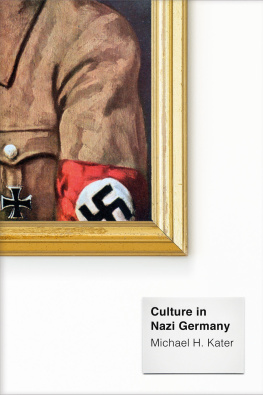Previously published in this series:
Medicine and Medical Ethics in Nazi Germany: Origins,
Practices, Legacies
Edited by Francis R. Nicosia and Jonathan Huener
Business and Industry in Nazi Germany
Edited by Francis R. Nicosia and Jonathan Huener
THE ARTS IN NAZI GERMANY

Continuity, Conformity, Change
Edited by
Jonathan Huener
and
Francis R. Nicosia

Berghahn Books
NEW YORK OXFORD
Published in 2006 by
Berghahn Books
www.berghahnbooks.com
2006, 2007, 2009 The Center for Holocaust Studies at
the University of Vermont
First paperback edition published in 2007
Paperback reprinted in 2009
All rights reserved. Except for the quotation of short passages
for the purposes of criticism and review, no part of this book
may be reproduced in any form or by any means, electronic or
mechanical, including photocopying, recording, or any information
storage and retrieval system now known or to be invented,
without written permission of the publisher.
Library of Congress Cataloging-in-Publication Data
The Arts in Nazi Germany: continuity, conformity, change / edited by Jonathan Huener and Francis R. Nicosia.
p. cm.
Includes bibliographical references and index.
ISBN 184545-2097 (hardback: alk. paper)
1. Arts, German20th centuryCongresses. 2. National social
ism and artGermanyCongresses. I. Huener, Jonathan
II. Nicosia, Francis R.
NX550.A1A85 2006
700.943'09043dc22
2006042834
British Library Cataloguing in Publication Data
A catalogue record for this book is available from
the British Library.
Printed in the United States on acid-free paper.
ISBN 9781-84545209-4 (hbk.) 9781-84545359-6 (pbk.)
CONTENTS

Introduction: The Arts in Nazi Germany:
Continuity, Conformity, Change
3. The Legacy of Nazi Cinema:
Triumph of the Will and Jew Sss Revisited
4. Music in the Third Reich:
The Complex Task of Germanization
5. A Command Performance?
The Many Faces of Literature under Nazism
6. The Art World in Nazi Germany:
Choices, Rationalization, and Justice
Appendixes
A. Letter from Wilhelm Furtwngler to Joseph Goebbels
12 April 1933
B. Law for the Establishment of a Provisional Chamber of Film
14 July 1933
C. The Reich Chamber of Culture Law
22 September 1933
D. First Decree for the Implementation of the Law for the
Reich Chamber of Culture
1 November 1933
E. Activities of the Cultural Association of German Jews
[Jewish Cultural League]
April 1934
F. The German Authorities and the Cultural Association
of German Jews [Jewish Cultural League]
19 June 1934
G. Ten Principles for the Creation of German Music
by Joseph Goebbels
28 May 1938
H. From Hitler's Speech on Culture (Kulturrede)
at the Nuremberg Party Congress
September 1938
I. What Are People Reading?
A Questionnaire in Berlin Book Stores
December 1940
PREFACE

THE SIX ESSAYS IN THIS BOOK ARE BASED ON LECTURES delivered at the Miller Symposium on The Arts in Nazi Germany, held at the University of Vermont in April 2004. Organized by the Center for Holocaust Studies at the University of Vermont, this was the third symposium bearing the name of Leonard and Carolyn Miller, generous supporters of the center's work and great friends of the university.
Established to honor the work of Professor Raul Hilberg, who served on the faculty of the University of Vermont for more than three decades, the Center for Holocaust Studies is committed to furthering the cause of Holocaust education and to serving as a forum for the presentation and discussion of new perspectives on the history of Nazi Germany and its crimes. Professor Hilberg's pioneering and ongoing research is a model and a standard for scholars, and it is his work in the field that remains an inspiration for the center's programming and for publications such as this. The Miller Symposia have contributed significantly to the center's efforts to explore insufficiently charted areas in the history of the Third Reich. Our goal in organizing them has been to address a topical, or even controversial, theme in the history of Nazi Germany and the Holocaust, relying on the expertise of some of the most accomplished authorities in the field.
The first Miller Symposium, held in April 2000, brought together some of the world's leading scholars in the history of eugenics and the German medical establishment during the Third Reich. It resulted in the anthology Medicine and Medical Ethics in Nazi Germany: Origins, Practices, Legacies, published by Berghahn Books in 2002. The second Miller Symposium, with its focus on German business and industry under National Socialism, took place in April 2002. It brought together scholars who are among the most respected and innovative analysts of business, industry, and finance in the years of the Third Reich. The resulting volume, Business and Industry in Nazi Germany, was published by Berghahn Books in 2004. The third Miller Symposium featured some of the most important scholars in the history of the arts in Nazi Germany. Their contributions to this volume address the roles of artists, writers, musicians, filmmakers, Jewish cultural institutions, American cultural influence, and German youth in the life of the Nazi state. Based on the authors' original scholarship, the essays assembled here serve as an introduction to some of the most current research and controversies in the history of the arts in the Third Reich.
These essays will be of interest to students and scholars of twentieth-century German history and the Nazi era, as well as those interested in the history of music, art, literature, and the cinema in Germany under National Socialism, and to general readers in the history of German culture, the Third Reich, and the Holocaust.
Both the Miller Symposium and this volume owe a tremendous debt to Leonard and Carolyn Miller, whose continuing support for the Center for Holocaust Studies has helped to sustain and expand its programming over the years. The editors also recognize and thank Wolfgang Mieder and the symposium's organizing committee, which included Kathy Johnson, David Scrase, and the editors of this volume. David Scrase deserves special thanks for his translations of some of the documents in the appendixes, as does Kathy Johnson for her tireless efforts, both in organizing the symposium itself and assembling materials for this publication. We are grateful as well to Kelly McDonald of Saint Michael's College for her help in the editing process. A final word of thanks is due to Michael Kater of York University for his contribution to the symposium and to this anthology. A contributor to the first Miller Symposium and to the volume on German medicine and medical ethics, and recognized around the world as a leading authority on the history of music in Nazi Germany, Professor Kater has played crucial roles in two of the three Miller Symposia and in the books that have resulted from them.
INTRODUCTION
The Arts in Nazi Germany:
Continuity, Conformity, Change

Jonathan Huener and Francis R. Nicosia
ON THE EVENING OF 25 JANUARY 1942, during one of his typically endless conversations at the Wolfsschanze that lasted long into the night, Adolf Hitler suggested to those in his company that the cultural life of the Reich, not politics, was his true passion and concern. He made the following confession to his guests:
Next page










